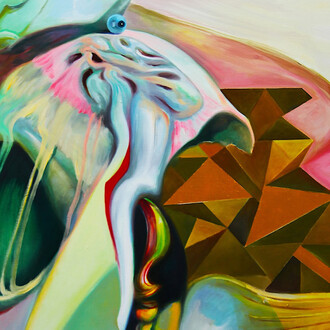Following announcement of representation in May 2024, Josh Kline will present his first solo exhibition with Lisson Gallery in New York in September.
For the artist’s inaugural exhibition with Lisson Gallery, Josh Kline presents a series of self-portraits for the first time, building on previous bodies of work to examine employment and the changing, precarious workforce. Titled Social media, Kline’s new suite of works approaches the selfie – one of the most common kinds of image on social media platforms – as a tool of critique, questioning our turbulent era’s obsession with the self. As he steps inside the 3D-scanning rig, Kline both turns the camera on himself and holds up a mirror to the conditions of artists in the third decade of the twenty-first century. The exhibition runs alongside Climate change, Kline’s solo exhibition at The Museum of Contemporary Art, Los Angeles, until January 2025, and follows his major mid-career survey exhibition, Project for a New American century (2023), at the Whitney Museum of American Art in New York.
Kline is known for charged, visceral installations that evoke contemporary retail environments, the starchitecture of global financial centers like New York and London, a disintegrating Western middle-class, ruinous floods, and surveillance zones. Mobilizing iconic elements of design, style and architecture that are both site and time-specific, his installations are immersive period pieces set in the present or all too possible futures. Kline’s earliest installations were made against the backdrop of and in response to the financial crisis and great recession, that also saw the first flowering of the smartphone-enabled social media platforms which would transform our lives. Now in this exhibition, Kline returns to the subject of his earliest installations: creative labor. In that body of work, produced between 2009-2014, the focus was on the challenges faced by creative workers – DJs, graphic designers, publicists and art directors – as they navigated promoting themselves as a persona online. Works such as Creative hands (2011) reproduced the hands of these workers as silicone casts, each clutching a tool that reflects the merging of their personal and professional identities, from an iPhone to a bottle of Advil or a computer mouse. In this new body of work, Kline abandons surrogates and uses his own image, focusing on the place of the artist in an art world increasingly described by its participants as “the art industry”. The sculptures that will debut at Lisson Gallery update core interests from that earlier body of work: the commodification, promotion, and disposal of the self in a society shaped by social media.
Kline brings to bear on his subject the vocabulary that he has developed and deployed over the last 15 years to depict contemporary class and labor. In Blue collars (2014–20) Kline interviewed blue-collar service industry workers such as waitresses, cleaners and delivery drivers in videos discussing their employment, aspirations, political views and the future, and created 3D printed portraits of these subjects in an assemblage of their bodies and the products and tools they used on the job, highlighting their working conditions in the aftermath of both offshoring and industrial automation of labor. Similarly, in the installation Unemployment (2016), Kline portrayed middle-class office workers predicted to face mass layoffs due to automation in the 2020s, 2030s and 2040s. The most iconic works from the project were disturbingly realistic life-size portraits of unemployed white-collar professionals in these vulnerable professions: a lawyer, banker, administrator, secretary, accountant, journalist. In this moment amid the rise of AI, and speculation about the coming obsolescence of creative workers, Kline adds visual artist to the list of at-risk professions. Now implicating himself in these labor portraits, Kline highlights the precarity of artists working with contemporary tools and in studios with unsustainable rents within increasingly tenuous cultural centers like New York City. Painstakingly rendering this obsolescence in hyperrealistic digital sculptural form, Social media immortalizes the aspirations and vulnerabilities of artists in the present day through the tools, presentation and consumption of art and the artist’s body itself.
















